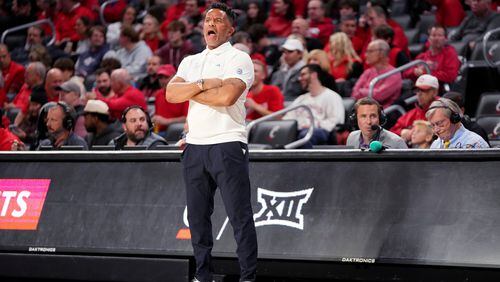AMELIA ISLAND, Fla. – Earlier this year, Wake Forest coach Dave Clawson said, a member of his team came to him to report that another school had reached out to him through a player about transferring to that school.
The message, Clawson said, was that “if he had interest in going, there was a scholarship available and a certain amount of name, image, likeness money that would become available.”
Given that the player reaching out to the Demon Deacons player likely wasn’t able to make that offer without the knowledge of his coach, it seemed a textbook definition of tampering, a reality that has become a major issue in the game, according to Clawson, speaking at the ACC spring meetings Wednesday.
“There’s a bunch of stories in that room like that,” said Clawson, referring to the conference room where the league’s coaches had been meeting this week.
Certainly, tampering in college sports – contacting players from another college before they’ve started the transfer process – has existed perhaps since the first days of college sports. But the transfer portal, put into place in 2018, and two NCAA rules changes instituted in 2021 – one permitting all athletes to transfer once without having to sit out a season and the other granting athletes the right to be compensated for their NIL rights – have made transferring a much easier and more inviting option.
As such, the transfer portal has become a critical component for roster building, with some coaches evidently skirting the rules to do so.
“It’s concerning,” said Clawson, a respected voice in the game who earlier this year was elected to represent the ACC on the American Football Coaches Association’s board of trustees. “We have a lot of discussion on it, and those discussions are private, but we’re certainly not ignoring it. We’re very aware of it.”
Former Pittsburgh wide receiver and Biletnikoff Award winner Jordan Addison’s decision to go into the transfer portal recently is viewed widely as a tampering case. But, as Clawson and other ACC coaches asserted this week, it’s rampant.
“It’s happened to a bunch of our players,” Miami coach Mario Cristobal said. “You just don’t know exactly how it’s happening, how it’s coming about, but it’s almost a free-enterprise aspect out there.”
Clawson said that coaches joked about how they should stop putting players with eligibility remaining on all-conference teams because such honors become de facto shopping lists for rival coaches.
A corresponding problem is that coaches believe that there is little that the NCAA can do to enforce tampering rules, both because of the difficulty in proving misconduct and also the NCAA’s slow-moving investigation and infraction process.
For instance, a player on Team A who is friends with a player on Team B and encourages him to transfer to Team A falls within the rules. But a coach directing a player to reach out to a player at another school is not. Contacting high-school coaches or other intermediaries also is against the rules. But being able to produce evidence that a situation is tampering would seem, at the least, a challenge.
In instances such as the one Clawson shared of a player on his player being approached by a player from another team, his response is to report it to the Wake Forest compliance office. From there, he held little confidence of action of it resulting in meaningful action from the NCAA’s enforcement arm.
“There doesn’t appear to be any enforcement, so nobody’s quite sure what the rules are, and it’s like a road without a speed limit,” Clawson said. “Or if the speed limit’s never enforced, they’re going to drive fast. So right now, we don’t know what the rules are, and if there are rules and they’re broken, there doesn’t appear to be any consequences for breaking them.”
About the Author





